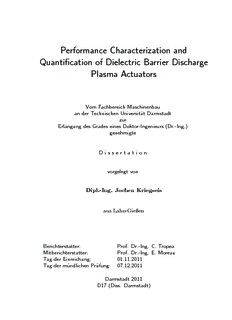
Performance Characterization and Quantification of Dielectric Barrier Discharge Plasma Actuators PDF
Preview Performance Characterization and Quantification of Dielectric Barrier Discharge Plasma Actuators
Performance Characterization and Quantification of Dielectric Barrier Discharge Plasma Actuators Vom Fachbereich Maschinenbau an der Technischen Universität Darmstadt zur Erlangung des Grades eines Doktor-Ingenieurs (Dr.-Ing.) genehmigte D i s s e r t a t i o n vorgelegt von Dipl.-Ing. Jochen Kriegseis aus Lahn-Gießen Berichterstatter: Prof. Dr.-Ing. C. Tropea Mitberichterstatter: Prof. Dr.-Ing. E. Moreau Tag der Einreichung: 01.11.2011 Tag der mündlichen Prüfung: 07.12.2011 Darmstadt 2011 D17 (Diss. Darmstadt) Hiermit versichere ich, die vorliegende Doktorarbeit unter der Betreuung von Prof.Dr.-Ing. C. Tropea und Dr.-Ing. S. Grundmann nur mit den angegebenen Hilfsmitteln selbständig angefertigt zu haben. Darmstadt, den 1. November 2011, Abstract The presentwork is an attempt to improve the characterizationandquan- tification of the performance of dielectric barrier discharge (DBD) plasma actuatorsforaerodynamicflow-controlapplications. Existingmeasurement and evaluation strategies, together with additional new approaches have been applied and are discussed extensively. Novel scaling numbers are in- troduced that yield universal and partly non-dimensional key quantities foranimprovedevaluationofthe electricaldischargecharacteristicsandof the environmentalinfluences about the behavior of plasma actuators. The existing strategies to quantify the momentum transfer from the plasma to the surrounding air are reviewed and have been applied to achieve a com- prehensive and comparative analysis of the respective differences based on experimentally obtained data. Direct and implicit as well as differential and integral force estimation approaches are discussed. To counteract in- fluences of the environment on the discharge and thus assuring constant plasma-actuator performance, a closed-loop control circuit of the electri- calsetupisintroducedandsuccessfullydemonstratedinaproof-of-concept experiment. i ii Kurzfassung Ziel dieser Arbeit ist die Verbesserung der Charakterisierung und Quan- tifizierung des Arbeitsverhaltens von dielektrischen Barriereentladungs- plasma-Aktuatoren im Hinblick auf Anwendungen zur aerodynamischen Strömungskontrolle. BeidendurchgeführtenUntersuchungenkamenbeste- hendeundneueMess-undAuswertungsstrategienzurAnwendung,dieaus- führlich diskutiert werden. Es werdenneuartige Maßzahleneingeführt, die als universelle und teilweise dimensionslose Kenngrößen eine verbesserte Evaluierung der Leistungsfähigkeit von Plasma-Akuatoren gestatten. Mit Hilfe dieser neuen Kennzahlen ist sowohl eine zuverlässige Erfassung von Entladungszustand und -intensität als auch eine präzise Beurteilung der Umgebungseinflüsse auf das Verhalten des Plasma-Aktuators möglich. Im Rahmen einer umfangreichen Vergleichsstudie fanden Experimente zur Quantifizierung der Impulsübertragung vom Plasma auf die umgebende Luft statt. Dabei kamen alle aktuell exisitierenden Verfahren zur An- wendung. Sie werden auf der Basis der erhaltenen experimentellen Daten gegenüberstellendanalysiert. BesondereBeachtungfindetdabeisowohldie Trennung von direkten und indirekten Methoden als auch die Unterschei- dungzwischenintegralenunddifferentiellenVerfahrenzurBestimmungder Kraft. UmdemEinflussderUmgebungsbedingungenaufdieGasentladung entgegenzuwirken, wurde das vorhandene elektrische Plasma-Aktuator- systemumeinenRegelkreiserweitert,dessenWirksamkeitaneinemBeispiel erfolgreichdemonstriert wird. iii iv Acknowledgements First of all I want to thank my doctoral adviser Prof. Dr.-Ing. Cameron Tropea,whogavemethechancetoaccomplishmyPh.Dprojectduringmy employment as a doctoral researcher at the Institute of Fluid Mechanics and Aerodynamics (SLA) and the Center of Smart Interfaces (CSI) of the Technische Universität Darmstadt. The infrastructure provided by him served as an excellent scientific environment for my research throughout the last five years. I would also like to thank Prof. Eric Moreau from the Université de Poitiers for refereeing this thesis. AspecialwordofthanksisowedtomymentorDr.-Ing. SvenGrundmann forallthe valuable advisesandfruitful discussions. The frequentexchange ofideasandconclusionswithhimconsiderablyimprovedthescientificlevel of the present work. In this context, I gratefully acknowledge the support of Dr.-Ing. Bettina Frohnapfel in the period, while Sven was not available in Griesheim. Emphasishastobeplacedonthepleasantclimateatwork,whichconsists ofandiscultivatedbythegroupoffriendlypeopleatthewind-tunnelfacili- tiesinGriesheim. InparticularIwishtothankDipl.-Ing. AndreasGüttler, Dr.-Ing. Matthias Kinzel, Dipl.-Ing. Lars Opfer and Dipl.-Ing. Andreas Reeh, who actually became good friends beyond work and research. I am truly grateful to my students B.Sc. Tobias Corneli, Dipl.-Ing. To- bias Dehler, M.Sc. Imdat Maden, Dipl.-Ing. Benjamin Möller, Dipl.-Ing. ClarissaSchönecker(néeSteffes),B.Sc. DanielSchröterandB.Sc. Clemens Schwarz. With their work they reasonably contributed to my research. Further acknowledgement is dedicated to Dipl.-Ing. Katrin Barckmann, Dipl.-Ing. Jürgen Frey and Dipl.-Ing. Armin Kurz for the technical assis- tanceusingthewind-tunnelfacilitiesinGriesheimandDresden. Additional words of thanks go to Ilona Kaufhold, Martin Weiß and their workshop teams for the ongoing support concerning the experimental setups. I would like to acknowledge the encouragement I have received over the years from all my friends and my family, especially from my parents. Fi- nally, I wish to express my gratefulness to Isabel for all the love, patience, understanding and unconditional support during the last years. v vi
Description: